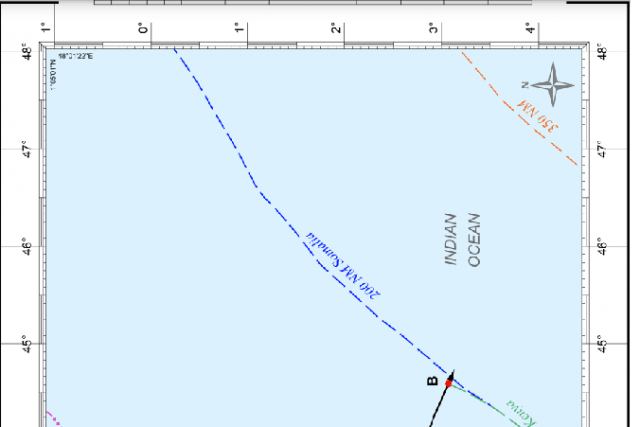Today the ICJ Judgement was released at the Hague, Netherlands made an important judgement. The ICJ released a judgement determining the maritime boundary between Kenya and Somalia.
The judges released a 5,000 word judgement titled Maritime Delimitation in the Indian Ocean (Somalia v. Kenya) case judgement.
The ICJ judgement is final without appeal and binding for the parties involved.
Finds that there is no agreed maritime boundary between the Federal Republic of Somalia and the Republic of Kenya that follows the parallel of latitude described in paragraph 35 [of the Judgment];
The ICC unanimously decides that the starting-point of the single maritime boundary delimiting the respective maritime areas between the Federal Republic of Somalia and the Republic of Kenya is the intersection of the straight line extending from the final permanent boundary beacon (PB 29) at right angles to the general direction of the coast with the low-water line, at the point with co-ordinates 1° 39′ 44.0″ S and 41° 33′ 34.4″ E (WGS 84).
The court unanimously decides that, from the starting-point, the maritime boundary in the territorial sea follows the median line described at paragraph 117 [of the Judgment] until it reaches the 12-nautical-mile limit at the point with co-ordinates 1° 47′ 39.1″ S and 41° 43′ 46.8″ E (WGS 84) (Point A).
By ten votes to four, decides that, from the end of the boundary in the territorial sea (Point A), the single maritime boundary delimiting the exclusive economic zone and the continental shelf up to 200 nautical miles
between the Federal Republic of Somalia and the Republic of Kenya follows the geodetic line starting with azimuth 114° until it reaches the 200-nautical-mile limit measured from the baselines from which the breadth of the territorial sea of the Republic of Kenya is measured, at the point with
co-ordinates 3° 4′ 21.3″ S and 44° 35′ 30.7″ E (WGS 84) (Point B).
The judges who voted in favor of the judgement are: President Donoghue; Vice-President Gevorgian; Judges Tomka, Bennouna, Xue, Sebutinde, Robinson, Iwasawa, Nolte; Judge ad hoc Guillaume.
Judges who ruled against are: Judges Abraham, Yusuf, Bhandari and Salam.
By nine votes to five, decides that, from Point B, the maritime boundary delimiting the continental shelf continues along the same geodetic line until it reaches the outer limits of the continental shelf or the area where the rights of third States may be affected.
READ MORE: The ICJ Judgement Was “Biased And Unfair” Uhuru Kenyatta Responds
IN FAVOUR: President Donoghue; Vice-President Gevorgian; Judges Tomka, Bennouna, Xue, Sebutinde, Iwasawa, Nolte; Judge ad hoc Guillaume;
AGAINST: Judges Abraham, Yusuf, Bhandari, Robinson, Salam;
The ICC unanimously rejects the claim made by the Federal Republic of Somalia in its final submission number 4 [concerning the allegation that the Republic of Kenya, by its conduct in the disputed area, had violated its international obligations].
On 28 August 2014, Somalia instituted proceedings against Kenya with regard to a dispute concerning the delimitation of maritime spaces claimed by both States in the Indian Ocean.
In its Application, Somalia requested the Court “to determine, on the basis of international law, the complete course of the single maritime boundary dividing all the maritime areas appertaining to Somalia and to Kenya in the Indian Ocean, including the continental shelf beyond 200 [nautical miles]”.
On 7 October 2015, Kenya raised preliminary objections to the jurisdiction of the Court and the admissibility of the Application.
On 2 February 2017, the Court rendered its Judgment on the preliminary objections raised by Kenya. The Court rejected those objections, finding that “it ha[d] jurisdiction to entertain the Application filed by the Federal Republic of Somalia on 28 August 2014 and that the Application [was] admissible”.
Public hearings on the merits of the case, initially scheduled to be held from 9 to 13 September 2019, were successively postponed to November 2019, June 2020 and March 2021, following requests for postponements made by Kenya. The hearings were held in a hybrid format between 15 and 18 March 2021, with the participation of the delegation of Somalia. Kenya did not participate in the hearings.
The International Court of Justice (ICJ) is the principal judicial organ of the United Nations. It was established by the United Nations Charter in June 1945 and began its activities in April 1946. The Court is composed of 15 judges elected for a nine-year term by the General Assembly and the Security Council of the United Nations. The seat of the Court is at the Peace Palace in The Hague (Netherlands). The Court has a twofold role: first, to settle, in accordance with international law, through judgments which have binding force and are without appeal for the parties concerned, legal disputes submitted to it by States; and, second, to give advisory opinions on legal questions referred to it by duly authorized United Nations organs and agencies of the system.
GOT a story? Contact Kerosi Dotcom on EMAIL info@kerosi.com



One thought on “ICJ judgement on maritime boundary between Kenya and Somalia”
Comments are closed.